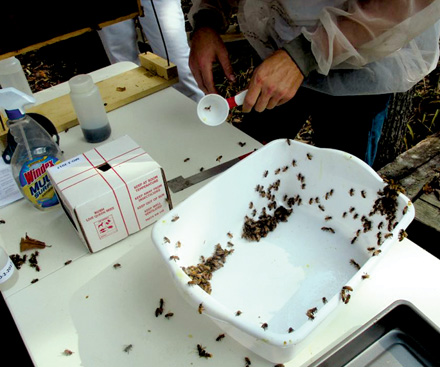Sampling Bee Hives

My apiary was among a dozen Missouri bee yards this fall participating for the first time in the National Honey Bee Survey. Missouri is the latest state to join the national hive sampling survey, representing the most comprehensive US honeybee pest and disease survey to date. Funded annually since 2009, the survey provides essential honeybee disease and pest base line information.
During the winter of 2006-2007, between 30-90% of US bee colonies died. Generally referred to as colony collapse disorder, the massive die off was a wake up call to commercial food suppliers who depend on bees for pollination. In particular, the California almond fields faced a year where they couldn’t get enough hives to travel west so bee imports were lifted to bring in Australian bee genetics, and bees, to keep almond fields pollinated.
By 2010, the imports were suspended to keep exotic pests and diseases from getting introduced to North America. To monitor what is happening in bee colonies around the country, the national survey was started to establish a base line of information. Then year to year, samples are checked for a variety of diseases and pests to track issues developing in bee colonies.
To maximize the survey information-collecting effort, samples will be analyzed for other honey bee diseases and parasites known to be present in the U.S. as well as more than 170 pesticides. A recent worldwide study on honey confirms there are pesticides in 75% of all honey, not a good development for the health of bees. Bees make honey for winter food.
The hive sampling process was simple. Once we found a relatively level spot on my one –acre hillside to set up a table, Lee Conner, with the Missouri Agriculture Department, put on his veil and headed to my first colony, Another beekeeper and I were suited up so we cracked the lid and stopped. It was an overcast day, the girls sounded quite cranky.
After a brief pause so Lee could put on his bee jacket, Lee told us what he needed – a typical brood frame with empty comb and live bees. Being careful that we didn’t have a queen on the frame, a little sugar water spray in a bowl convinced 1⁄4 cup of bees to stay long enough for the live sample; another 1⁄4 cup went into an alcohol wash for other testing.
Once the brood frame was empty, it was knocked on the table a few times to get a sample of material on the frame. Small hive beetles were taking off so I made sure small hive beetle bodies were in that pile. Then a quarter-size of empty comb was removed and placed in a separate container.
One colony was done, another seven to go. Once all of the samples were collected, Lee headed to the post office to ship the live samples off.
To qualify for the survey, the apiary has to have at least 10 colonies and be within the geographic area they haven’t already sampled. A total of 24 apiaries are getting sampled in every state except California, where 48 apiaries will be sampled.
Charlotte Ekker Wiggins is a beekeeper, gardener and sometimes cook. Published by El Dorado Springs Sun once in print and online with author’s permission. Copyright 2017, all rights reserved. This column may not be reprinted, republished or otherwise distributed without author’s permission. Contact Charlotte at gardeningcharlotte at gmail dot com.

KEEP THE HIVE ALIVE – Lee Conner works at a temporary table set up in my garden to collect bees for sampling later at the University of Maryland Bee Lab.



Facebook Comments